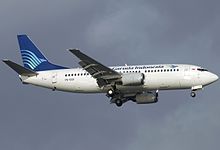Garuda Indonesia Flight 421

A Garuda Indonesia Boeing 737-3Q8, similar to the accident aircraft.
|
|
| Accident summary | |
|---|---|
| Date | January 16, 2002 |
| Summary | Flameout of both engines in heavy rain/hail |
| Site |
Bengawan Solo River 7°40′03″S 110°46′48″E / 7.66750°S 110.78000°ECoordinates: 7°40′03″S 110°46′48″E / 7.66750°S 110.78000°E |
| Passengers | 54 |
| Crew | 6 |
| Fatalities | 1 (flight attendant) |
| Survivors | 59 |
| Aircraft type | Boeing 737-3Q8 |
| Operator | Garuda Indonesia |
| Registration | PK-GWA |
| Flight origin | Selaparang Airport, Ampenan, Indonesia |
| Destination | Adisucipto International Airport, Yogyakarta, Indonesia |
Garuda Indonesia Flight 421 was a scheduled domestic flight operated by Indonesian flag carrier Garuda Indonesia travelling about 625 km (388 mi) from Ampenan to Yogyakarta. On January 16, 2002, the flight encountered severe thunderstorm activity during approach to its destination, suffered flameout in both engines, and ditched in a shallow river, resulting in one fatality and several injuries.
The aircraft, a Boeing 737-3Q8, registration PK-GWA, was manufactured in 1988 and delivered in 1989 It was the first 737 flown by Garuda Indonesia.
As the Boeing 737-300 aircraft was on approach to its destination, the pilots were confronted with substantial thunderstorm activity visible ahead and on their onboard weather radar. They attempted to fly between two intense weather cells visible on their radar. They later entered a thunderstorm containing heavy rain and hail. About 90 seconds later, as the aircraft was descending through 19,000 ft (5,800 m), both CFM International CFM56 engines experienced a flameout, which resulted in the loss of all generated electrical power. Both engines were set at their flight-idle power setting before flameout occurred. The crew tried unsuccessfully to restart the engines two or three times. They then tried but failed to start the auxiliary power unit (APU), at which time total electrical power loss occurred. (During the later investigation, the NiCd battery was found to have been in poor condition due to inadequate maintenance procedures.) The co-pilot attempted to transmit a Mayday call, but was unable. As the aircraft descended through the lower layer of clouds at approximately 8,000 ft (2,400 m), the pilots saw the Bengawan Solo River and decided to attempt to ditch in the river with the flaps and gear retracted. The ditch procedure was successful, leaving the aircraft settled down on its belly in the shallow water, with the fuselage, wings and control surfaces largely intact. There was no fire.
Only two doors were available for evacuation. Residents of nearby villages assisted. Uninjured passengers and their personal belongings were temporarily sheltered in a nearby empty house, while injured passengers were transported by an available vehicle to the nearest clinic. After evacuation, the pilot contacted the Jogja Tower via cellphone and reported the emergency landing and location. The rescue team arrived about two hours later and all remaining passengers and crew were taken safely to a hospital.
...
Wikipedia
